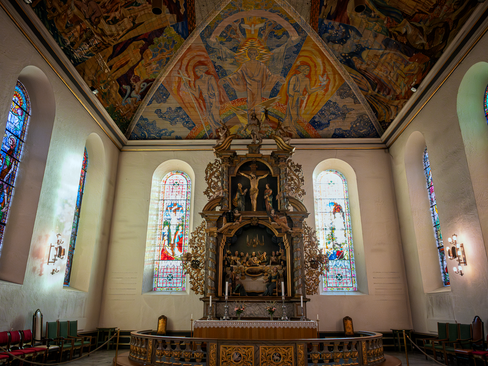Oslo, Norway: February 9 - 11, 2025
- Cecilia Clark
- Mar 24
- 5 min read

On February 9 we took the train back to Oslo. The train stopped at every small ski area and town to pick up and drop off passengers many with skies or boards. We passed mountains and lakes and small groups of houses. The train did not have WiFi that worked for us so I read or took cell phone photos not sure of what I'd be able to capture through the window from a moving train.
The train left about 8:00 am, and we arrived at the Oslo Central Station about 3:00 pm. Our hotel, The Amerikalinjen, was across from the Central Station. We stayed in Oslo for 2 nights which allowed us to see some of the sights we missed on our first stay.
While Oslo Cathedral had its origins in 1697, it is actually the third church built on this site. The first church, St. Hallvard's Cathedral, was erected 900 years earlier in the medieval City of Oslo. This third version has been lovingly renovated and added to. Oslo Cathedral is a Luthern Church within the Church of Norway. The church is beautiful, but I was most impressed with the spectacular ceiling paintings. Artist Hugo Lous Mohr painted the 1500 square foot ceiling between 1937 and 1950 for the last major renovation of the cathedral. The painting flows from the center medallion and highest point of the cathedral to each Apse panel. I was intrigued by the painted textures the artist created: netting and a stone-like pattern within many of the solid colors.
We continued up the pedestrian street toward Parliament passing blocks of designer shops. At Parliament, I wanted to take a symetrical photo of the building but as I was getting ready to shoot, a woman wandered over and stood in the exact center where I had planned to stand. She proceeded to put on many layers of clothing and took out a towel and a sign which she then placed on the ground. Then, I figured it out. She is silently (stillhet) protesting against the things that cause climate change. In particular oil and Norway's oil drilling. Right now it is quite cold and she shows up when the sun begins to peek around the Parliament building. The iStillhetForKlima Facebook page shows that this silent, peaceful protest began in 2019. Sometimes many people, all ages, show up for the sit in. Sometimes it is just one person, but the movement keeps going regardless of the weather.
We had a conversation both expressing our dismay about the USA's 2024 election and the aftermath. She said she had a room for me if I decided to move to Norway. It is something I think about!
We walked to the Royal Palace and through the garden path. The gardens were covered with snow but it was a sunny day and a good day for a walk..
Our destination was the most visited park in Oslo: Vigeland Park within Frogner Park. We stopped to look at our map to make sure we were on the right path. A very nice Norwegian man stopped to see if we needed help, and he confirmed our direction.
Vigeland Park contains the lifework, 200 sculptures in bronze, granite, and wrought iron (main gate), of Gustav Vigeland (1869-1943). The planning of Frogner Park began in 1902. The collection is the result of an agreement with Gustav Vigeland made with the City of Oslo in 1919. He donated all his art to the city and the city built him a studio which became the museum after his death. In 1924 the city decided to incorporate Vigeland's plan for his sculptures. The park officially opened on June 2, 1993. The park is beautiful even covered by several inches of snow. The Vigeland Museum was closed as it was Monday. The park is open 365 days a year/24 hours a day.
Fifty-eight bronze sculptures of men, women, and children are installed on pedestals along the bridge (below). Beyond the bridge a path leads through a rose garden to the fountain (last 2 photos). Note that because it was winter the fountain was not running and the roses were dormant. The fountain centerpiece is the basin the six giant men hold aloft. Below, a square wall supports 20 tree groups of people of various ages from childhood to old age.
The column below is "The Monolith." It stands at the highest point in the park measuring 17 m/55 ft above ground. There are 121 human figures (men, women and children) clinging and floating together with only children at the top. There are different interpretations, but the artist said "The column is my religion." Unfortunately, when I saw the glob of writhing human figures, a vision of red wriggler worms (the ones we use of composting) immediately popped into my mind. The granite sculptures around the Monolith represent men, women, children at all stages of life. The Circle of Life theme with play, lust, anger, love, energy, and other human emotions is repeated in many versions throughout the park.
In 1901 Vigeland was invited by the Norwegian Nobel Committee to participate in a closed competition for the Nobel Peace Prize medal. Vigeland's design was accepted and the medal was first bestowed upon the winners in December 1902. The design has three male figures holding each other's shoulders on one side and a profile of Alfred Nobel on the other side (Below Photo: Vigelandmuseet). The irregularity and placement of the lettering for "Pro Pace Et Fraternitate Gentium" (Peace and Brotherhood between Nations) makes the award look like an ancient Roman coin. The actual coin is gold.

We stayed in the park for quite a while and also had lunch. Leaving, the light was already getting low and we had a long walk back to our hotel. Our path took us by the amazing National Library with its medieval manuscripts and treasures, the Nobel Peace Center, City Hall, and Akershus Fortress where we watched the setting sun.
The National Library in Oslo is part library as we know it and part Library of Congress in that their collection is home to Norwegian knowledge and heritage. The desk clerk at our hotel recommended we take a look. Entrance is free and open to the public. It is open everyday but Sunday and during the week it is open 9 to 9. Such a contrast from the limited hours our local library is available. The Library began digitizing its entire collection (from Middle Ages to current) in 2006 and it is estimated that it will take 20-30 years for the entire collection to be digitized. There is an agreement between the library and newspaper organizations to furnish digital copies of new and historical archives. Books written in Norwegian must be digitized and provided to the Library. Books from the entire 20th century are available to anyone with a Norwegian IP address, and if not copyrighted, can be downloaded. Their Map Center contains the world's most extensive collection of printed maps of Norway, Nordic countries, and the High North. The maps range in age from 1482 to the late 1800s.
The Nobel Peace Center (first photo) is a museum. It is closed on Monday so we could not visit. Across the walkway is Oslo's City Hall where the Nobel Peace Prize ceremony is held every December 10 (the anniversary of Alfred Nobel's death). The medal can't be minted until the laureate's name(s) are announced as his/her name will be engraved along the edge the medal.
A sculpture of Winston Churchill is installed near the National Library, and Franklin D. Roosevelt is represented in a statue near the Akershus Fortress. The roots of the Fortress date back to around 1300 when the medieval castle was built and Oslo became Norway's capital. In 2002 the Norwegian parliament opened the fortress to the pubic. It is a great place to sit and watch the sunset.
We made it back to the hotel after dark and the next day caught the Flytoget train to the airport and flew to Helsinki.
Particulars:
Amerikalinjen Hotel, across from the Oslo Central Station, convenient location, lovely rooms and common areas, and a great breakfast.













































































Comments